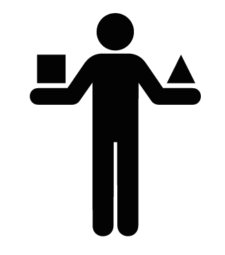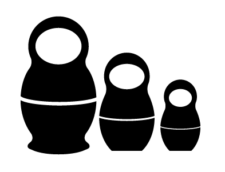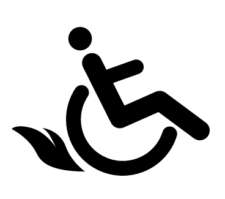5.9: Adjectives and Adverbs
- Last updated
- Save as PDF
- Page ID
- 23356
Learning Objectives
- Identify functions of adjectives and adverbs
- Identify differences between adjectives and adverbs
- Identify common mistakes with adjectives and adverbs
Adjectives and adverbs describe things. For example, compare the phrase “the bear” to “the red bear” or the phrase “run” to “run slowly.”
In both of these cases, the adjective (red) or adverb (slowly) changes how we understand the phrase. When you first read the word bear, you probably didn’t imagine a red bear. When you saw the word run you probably didn’t think of it as something done slowly.
Adjectives and adverbs modify other words; they change our understanding of things.
For a catchy introduction to these words in song, watch the following videos.
Functions of Adjectives

Figure \(\PageIndex{1}\)
An adjective modifies a noun; that is, it provides more detail about a noun. This can be anything from color to size to temperature to personality. Adjectives usually occur just before the nouns they modify. In the following examples, adjectives are in bold, while the nouns they modify are in italics (the big bear):
- The generator is used to convert mechanical energy into electrical energy.
- The steel pipes contain a protective sacrificial anode and are surrounded by packing material.
Adjectives can also follow a linking verb. In these instances, adjectives can modify pronouns as well. In the following examples, adjectives are still bold, while the linking verb is in italics this time (the sun is yellow):
- The schoolhouse was red.
- I looked good today.
- She was funny.
Numbers can also be adjectives in some cases. When you say “Seven is my lucky number,” seven is a noun, but when you say “There are seven cats in this painting,” seven is an adjective because it is modifying the noun cats.
Exercise \(\PageIndex{1}\)
Identify the adjectives in the following sentences:
- Of the four seasons, fall is my favorite; I love the red leaves, the cool weather, and the brisk wind.
- My roommate, on the other hand, thinks that summer is the best season.
- I think she is crazy.
- Fall is better than summer. Summer is too hot and muggy to be enjoyable.
- Answer
-
The adjectives have been bolded in the sentences below:
- Of the four seasons, fall is my favorite; I love the red leaves, the cool weather, and the brisk wind.
- My roommate, on the other hand, thinks that summer is the best season.
- I think she is crazy.
- Fall is better than summer. Summer is too hot and muggy to be enjoyable. (All of these adjectives follow linking verbs.)
Comparable Adjectives

Figure \(\PageIndex{2}\)
Some adjectives are comparable. For example, a person may be polite, but another person may be more polite, and a third person may be the most polite of the three. The word more here modifies the adjective polite to indicate a comparison is being made (a comparative), and most modifies the adjective to indicate an absolute comparison (a superlative).
There is another way to compare adjectives in English. Many adjectives can take the suffixes –er and –est (sometimes requiring additional letters before the suffix; see forms for far below) to indicate the comparative and superlative forms, respectively:
- great, greater, greatest
- deep, deeper, deepest
- far, farther, farthest
Some adjectives are irregular in this sense:
- good, better, best
- bad, worse, worst
- little, less, least
Another way to convey comparison is by incorporating the words more and most. There is no simple rule to decide which means is correct for any given adjective, however. The general tendency is for shorter adjectives to take the suffixes, while longer adjectives do not—but sometimes sound of the word is the deciding factor.
more beautiful not beautifuller
more pretentious not pretentiouser
While there is no perfect rule to determine which adjectives will or won’t take –er and –est suffixes, this video lays out some “sound rules” that can serve as helpful guidelines:
Note
The adjective fun is one of the most notable exceptions to the rules. If you follow the sound rules we just learned about, the comparative should be funner and the superlative funnest. However, for a long time, these words were considered non-standard, with more fun and most fun acting as the correct forms.
The reasoning behind this rule is now obsolete (it has a lot to do with the way fun became an adjective), but the stigma against funner and funnest remains. While the tides are beginning to change, it’s safest to stick to more fun and most fun in formal situations (such as in academic writing or in professional correspondence).
Exercise \(\PageIndex{2}\)
What are the correct comparative and superlative forms for the adjectives below?
| Adjective | Comparative | Superlative |
|---|---|---|
| fun | more fun (or funner, conversationally) | most fun (or funnest, conversationally) |
| red | ||
| shimmery | ||
| fresh | ||
| popular | ||
| squishy | ||
| quiet | ||
| large |
- Answer
-
Adjective Comparative Superlative fun more fun (or funner, conversationally) most fun (or funnest, conversationally) red redder reddest shimmery more shimmery most shimmery fresh fresher freshest popular more popular most popular squishy squishier squishiest quiet quieter quietest large larger largest
Non-Comparable Adjectives
Many adjectives do not naturally lend themselves to comparison. For example, some English speakers would argue that it does not make sense to say that one thing is “more ultimate” than another, or that something is “most ultimate,” since the word ultimate is already an absolute. Such adjectives are called non-comparable adjectives. Other examples include dead, true, and unique.
Non-Comparable Adjectives
Many adjectives do not naturally lend themselves to comparison. For example, some English speakers would argue that it does not make sense to say that one thing is “more ultimate” than another, or that something is “most ultimate,” since the word ultimate is already an absolute. Such adjectives are called non-comparable adjectives. Other examples include dead, true, and unique.
Note
Native speakers will frequently play with non-comparable adjectives. Although pregnant is logically non-comparable (someone is pregnant or she is not), you may hear a sentence like “She looks more and more pregnant each day.” Likewise extinct and equal appear to be non-comparable, but one might say that a language about which nothing is known is “more extinct” than a well-documented language with surviving literature but no speakers, and George Orwell once wrote “All animals are equal, but some are more equal than others.”
Functions of Adverbs

Figure \(\PageIndex{3}\)
Adverbs can perform a wide range of functions: they can modify verbs, adjectives, and even other adverbs. They can come either before or after the word they modify. In the following examples, adverbs are in bold, while the words they modify are in italics (the quite handsome man):
- The desk is made of an especially corrosion-resistant industrial steel.
- The power company uses huge generators which are generally turned by steam turbines.
- Jaime won the race, because he ran quickly.
- This fence was installed sloppily. It needs to be redone.
An adverb may provide information about the manner, place, time, frequency, certainty, or other circumstances of the activity indicated by the verb. Some examples, where again the adverb is in bold and the words modified are in italics:
- Suzanne sang loudly (loudly modifies the verb sang, indicating the manner of singing)
- We left it here (here modifies the verb phrase left it, indicating place)
- I worked yesterday (yesterday modifies the verb worked, indicating time)
- He undoubtedly did it (undoubtedly modifies the verb phrase did it, indicating certainty)
- You often make mistakes (often modifies the verb phrase make mistakes, indicating frequency)
They can also modify noun phrases, prepositional phrases, or whole clauses or sentences, as in the following examples. Once again the adverbs are in bold, while the words they modify are in italics.
- I bought only the fruit (only modifies the noun phrase the fruit)
- Roberto drove us almost to the station (almost modifies the prepositional phrase to the station)
- Certainly we need to act (certainly modifies the sentence as a whole)
Exercise \(\PageIndex{3}\)
Identify the adverbs in these paragraphs:
Mass extinctions are insanely catastrophic—but important—events that punctuate the history of life on Earth. The Jurassic/Cretaceous boundary was originally thought of to represent a mass extinction, but has subsequently been “downgraded” to a minor extinction event based on new discoveries.
However, compared to other important stratigraphic boundaries, like the end-Triassic or the end-Cretaceous, the Jurassic/Cretaceous boundary remains really poorly understood.
- Answer
-
There are five adverbs in the paragraphs:
insanely; originally; subsequently; really; poorly
Here the adverbs have been bolded:
Mass extinctions are insanely catastrophic—but important—events that punctuate the history of life on Earth. The Jurassic/Cretaceous boundary was originally thought of to represent a mass extinction, but has subsequently been “downgraded” to a minor extinction event based on new discoveries.
However, compared to other important stratigraphic boundaries, like the end-Triassic or the end-Cretaceous, the Jurassic/Cretaceous boundary remains really poorly understood.
Intensifiers and Adverbs of Degree
Adverbs can also be used as modifiers of adjectives, and of other adverbs, often to indicate degree. Here are a few examples:
- You are quite right (the adverb quite modifies the adjective right)
- Milagros is exceptionally pretty (the adverb exceptionally modifies the adjective pretty)
- She sang very loudly (the adverb very modifies another adverb—loudly)
- Wow! You ran really quickly! (the adverb really modifies another adverb—quickly)
Other intensifiers include mildly, pretty, slightly, etc.
This video provides more discussion and examples of intensifiers:
Note
Adverbs may also undergo comparison, taking comparative and superlative forms. This is usually done by adding more and most before the adverb (more slowly, most slowly). However, there are a few adverbs that take non-standard forms, such as well, for which better and best are used.
Differences Between Adjectives and Adverbs
As we’ve learned, adjectives and adverbs act in similar but different roles. A lot of the time this difference can be seen in the structure of the words:
- A clever new idea.
- A cleverly developed idea.
Clever is an adjective, and cleverly is an adverb. This adjective + ly construction is a short-cut to identifying adverbs.
While –ly is helpful, it’s not a universal rule. Not all words that end in –ly are adverbs: lovely, costly, friendly, etc. Additionally, not all adverbs end in -ly: here, there, together, yesterday, aboard, very, almost, etc.
Note
Some words can function both as an adjective and as and adverb:
- Fast is an adjective in “a fast car” (where it qualifies the noun car), but an adverb in “he drove fast” (where it modifies the verb drove).
- Likely is an adjective in “a likely outcome” (where it modifies the noun outcome), but an adverb in “we will likely go” (where it modifies the verb go).
Common Mistakes with Adjectives and Adverbs
Mistaking Adverbs and Adjectives
One common mistake with adjectives and adverbs is using one in the place of the other. For example:
- I wish I could write as neat as he can.
- The word should be neatly, an adverb, since it’s modifying a verb.
- Well, that’s real nice of you.
- Should be really, an adverb, since it’s modifying an adjective
Remember, if you’re modifying a noun or pronoun, you should use an adjective. If you’re modifying anything else, you should use an adverb.
Good v. Well
One of the most commonly confused adjective/adverb pairs is good versus well. There isn’t really a good way to remember this besides memorization. Good is an adjective. Well is an adverb. Let’s look at a couple of sentence where people often confuse these two:
She plays basketball good.
In this sentence good is supposed to be modifying plays, a verb; therefore the use of good—an adjective—is incorrect. Plays should be modified by an adverb. The correct sentence would read “She plays basketball well.”
I’m doing good.
In this sentence, good is supposed to be modifying doing, a verb. Once again, this means that well—an adverb—should be used instead: “I’m doing well.”
Note
The sentence “I’m doing good” can be grammatically correct, but only when it means “I’m doing good things,” rather than when it is describing how a person is feeling.
Exercise \(\PageIndex{4}\)
Select the correct modifier for each sentence:
- Billy has to work (real / really) hard to be (healthy / healthily).
- Kate is really (good / well) with bows. She shoots really (good / well).
- Eli reads (quick / quickly), and he retains the information (good / well).
- Answer
-
- Billy has to work really hard to be healthy.
- Remember that to be is a linking verb. Linking verbs often connect the subject of the sentence (Billy) to an adjective that describes it (healthy).
- Kate is really good with bows. She shoots really well.
- Eli reads quickly, and he retains the information well.
Adjectives
If you’re a native English speaker, you may have noticed that “the big red house” sounds more natural than “the red big house.” The video below explains the order in which adjectives occur in English:
Exercise \(\PageIndex{5}\)
Select the adjectives that are in a natural sounding word order for each sentence.
- She found a(n) _______ record in her attic
- dusty, Jazz, old
- old, dusty, Jazz
- Jazz, dusty, old
- He walked into a pole because he was distracted by a(n) _____ dog.
- adorable, tiny, brown
- tiny, adorable, brown
- tiny, brown, adorable
- The crowd was astounded when the professional chess player arrived wearing a(n) ____ suit to his match.
- antique, blue, cashmere
- cashmere, blue, antique
- blue, antique, cashmere
- For her daughter’s birthday, she made a(n) _____ doll house.
- cute, wooden, yellow
- wooden, yellow, cute
- cute, yellow, wooden
- Answer
-
- b. old, dusty, Jazz
- a. adorably, tiny, brown
- a. antique, blue, cashmere
- c. cute, yellow, wooden
Adverbs
Only
Have you ever noticed the effect the word only can have on a sentence, especially depending on where it’s placed? Let’s look at a simple sentence:
She loves horses.
Let’s see how only can influence the meaning of this sentence:
- Only she loves horses.
- No one loves horses but her.
- She only loves horses.
- The one thing she does is love horses.
- She loves only horses.
- She loves horses and nothing else.
Only modifies the word that directly follows it. Whenever you use the word only make sure you’ve placed it correctly in your sentence.
Literally
A linguistic phenomenon is sweeping the nation: people are using literally as an intensifier. How many times have you heard things like “It was literally the worst thing that has ever happened to me,” or “His head literally exploded when I told him I was going to be late again”? Some people love this phrase, while it makes other people want to pull their hair out.
So what’s the problem with this? According to Merriam-Webster’s Dictionary, the actual definition of literal is as follows:
- involving the ordinary or usual meaning of a word
- giving the meaning of each individual word
- completely true and accurate : not exaggerated[1]
According to this definition, literally should be used only when something actually happened. Our cultural usage may be slowly shifting to allow literally as an intensifier, but it’s best to avoid using literally in any way other than its dictionary definition, especially in formal writing.
Exercise \(\PageIndex{6}\)
Which of the following sentences use the adverb literally correctly?
- David often takes things too literally.
- Tommy literally died when he heard the news.
- Teddy is literally the best person on the planet.
- Answer
-
- This sentence is correct.
- This sentence is incorrect (hopefully). Try replacing literally with practically or nearly.
- This sentence may or may not be true; it’s something that would be very hard to verify. When you’re being purposefully hyperbolic, this may be okay in a non-formal setting, but you may want to consider replacing literally with an intensifier like actually or omitting the adverb altogether, since literally has such a stigma around it.
Self-Check
References
- "Literal." Merriam-Webster.com. Merriam-Webster, n.d. Web. 20 June 2016. ↵

